|
Terra Mystica
Authors: Jens Drögemüller & Helge Ostertag
Publisher: Feuerland Spiele
Year: 2012
review by

| x |
|
|
|
|
|
|
|
|
|
|
|
|
|
|
|
|
|
|
|
|
|
|
|
|
|
|
|
|
|
|
|
|
|
|
|
|
|
|
|
|
|
|
|
|
|
|
|
|
|
|
|
|
|
|
|
|
|
|
|
 |
In Terra Mystica two to five fantasy races meet each other on the battlefield… No, wait! This time the dwarves, giants, nomads and the like have actually learned to coexist peacefully! Trading houses profit from contact with neighbors, nearby building activity provides power, and well, if someone builds a dwelling now and then on a piece of land someone else also had their eye on, that’s acceptable, right?
|
|
|
| x |
|
|
|
|
|
|
|
|
|
|
|
|
|
|
|
|
|
|
|
|
|
|
|
|
|
|
|
|
|
|
|
|
|
|
|
|
|
|
|
|
|
|
|
|
|
|
|
|
|
|
|
|
|
|
|
|
|
|
|
|
Terra Mystica is played over six rounds. There are 14 factions available in seven different colors, and each faction has one or more special powers. Also, each faction can only build dwellings on one of the seven terrain types depicted on the game board. Everybody starts with a number of dwellings on the board (usually two), a handful of money and workers and a bonus card that gives some additional advantage, such as extra income or possible bonus points. In addition there are four cult tracks (water, air, fire and earth) with most factions having some starting knowledge in or two of them.
|
|
|
| x |
|
|
|
|
|
|
|
|
|
|
|
|
|
|
|
|
|
|
|
|
|
|
|
|
|
|
|
|
|
|
|
|
|
|
|
|
|
|
|
|
|
|
|
|
|
|
|
|
|
|
|
|
|
|
|
|
|
|
|
 |
| x |
|
|
|
|
|
|
|
|
|
|
|
|
|
|
|
|
|
|
|
|
|
|
|
|
|
|
|
|
|
|
|
|
|
|
|
|
|
|
|
|
|
|
|
|
|
|
|
|
|
|
|
|
|
|
|
|
|
|
|
|
Every round starts with the income phase, with the players’ income being mainly dependent on what kind of structures they have on the game board. For example dwellings provide workers and trading houses mainly money and power. Then every player in turn takes an action, and this goes on until everyone has passed. An important action is building a new dwelling. This is done adjacent to an own existing structure, while paying a combination of money and workers. But, as mentioned earlier, every faction can only build on one specific terrain type, and of course life is not so simple that all the identical terrains are adjacent to each other. Fortunately every faction is able to transform terrains to the type they prefer. This costs a number of ‘spades’, varying from one to three depending on how closely the terrain in question resembles their preferred habitat. Spades are paid for with workers, with the standard ‘exchange rate’ being three workers per spade. Actions like improving this exchange rate or increasing the shipping capabilities of your faction facilitate expansion.
|
|
|
| x |
|
|
|
|
|
|
|
|
|
|
|
|
|
|
|
|
|
|
|
|
|
|
|
|
|
|
|
|
|
|
|
|
|
|
|
|
|
|
|
|
|
|
|
|
|
|
|
|
|
|
|
|
|
|
|
|
|
|
|
 |
| x |
|
|
|
|
|
|
|
|
|
|
|
|
|
|
|
|
|
|
|
|
|
|
|
|
|
|
|
|
|
|
|
|
|
|
|
|
|
|
|
|
|
|
|
|
|
|
|
|
|
|
|
|
|
|
|
|
|
|
|
|
Another available action is upgrading an existing structure: dwellings can be upgraded to trading houses, which in turn can become temples or a stronghold. Also a temple can be upgraded to a sanctuary. Upgrading costs a considerable amount of money and workers, but also brings advantages: building the stronghold unlocks the faction’s additional special power (this can be a one-off or a permanent power), and building temples and the sanctuary is rewarded with a favor tile of choice: these provide one to three steps on of the cult tracks and (except for the tiles with three steps) an additional advantage. Whoever succeeds in building enough structures adjacent to each other automatically founds a town and is assured of further victory points. For people focusing on the cult track there is also the possibility to send a priest to a cult of their choice, but spaces are limited!
|
|
|
| x |
|
|
|
|
|
|
|
|
|
|
|
|
|
|
|
|
|
|
|
|
|
|
|
|
|
|
|
|
|
|
|
|
|
|
|
|
|
|
|
|
|
|
|
|
|
|
|
|
|
|
|
|
|
|
|
|
|
|
|
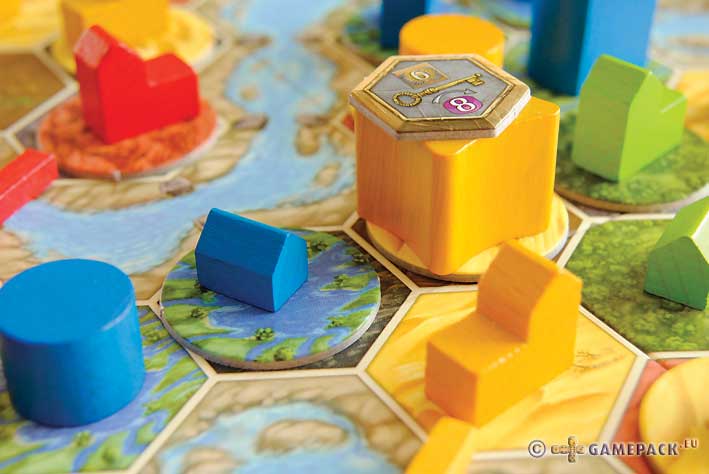 |
| x |
|
|
|
|
|
|
|
|
|
|
|
|
|
|
|
|
|
|
|
|
|
|
|
|
|
|
|
|
|
|
|
|
|
|
|
|
|
|
|
|
|
|
|
|
|
|
|
|
|
|
|
|
|
|
|
|
|
|
|
|
Every round there are also power actions available. Players can receive power as income, and when a structure is built next to them. Through these actions this power can be converted to a bridge (which makes expansion easier), a priest, workers, money, or one or two free spades. Every one of these actions can only be picked by one person each round.
|
|
|
| x |
|
|
|
|
|
|
|
|
|
|
|
|
|
|
|
|
|
|
|
|
|
|
|
|
|
|
|
|
|
|
|
|
|
|
|
|
|
|
|
|
|
|
|
|
|
|
|
|
|
|
|
|
|
|
|
|
|
|
|
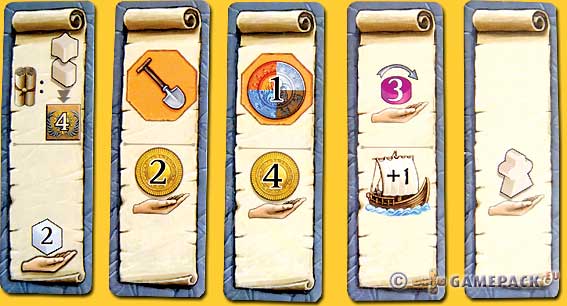 |
|
|
|
|
|
|
|
|
|
|
| x |
|
|
|
|
|
|
|
|
|
|
|
|
|
|
|
|
|
|
|
|
|
|
|
|
|
|
|
|
|
|
|
|
|
|
|
|
|
|
|
|
|
|
|
|
|
|
|
|
|
|
|
|
|
|
|
|
|
|
|
|
Sooner or later in a round everyone realizes there is not much more to do without new income: then the time has come to pass. When passing you choose a new bonus card from the display and turn in your old one (which might provide someone else with the incentive to pass as well in order to obtain this card), and the first player to pass in a round is the starting player for the next round. When everyone has passed the cult bonuses are paid out. Every round has a scoring tile depicting two bonuses: on the left side how you can gain extra points during the round (for example by building trading houses or founding a town), and on the right side a cult bonus dependent on the progression on a certain cult track, such as a free worker for every two steps in the cult of fire, or a free priest for every four steps on the cult of water.
|
|
|
| x |
|
|
|
|
|
|
|
|
|
|
|
|
|
|
|
|
|
|
|
|
|
|
|
|
|
|
|
|
|
|
|
|
|
|
|
|
|
|
|
|
|
|
|
|
|
|
|
|
|
|
|
|
|
|
|
|
|
|
|
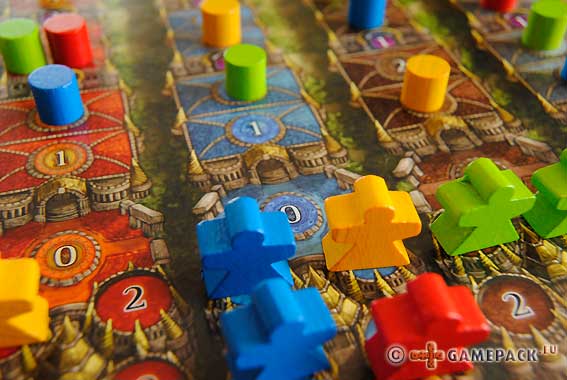 |
|
|
|
|
|
|
|
|
|
|
| x |
|
|
|
|
|
|
|
|
|
|
|
|
|
|
|
|
|
|
|
|
|
|
|
|
|
|
|
|
|
|
|
|
|
|
|
|
|
|
|
|
|
|
|
|
|
|
|
|
|
|
|
|
|
|
|
|
|
|
|
|
At the end of the last round the cult bonus is not paid out; instead the final scoring takes place. Points are given to the player with the largest area of adjacent structures (with bridges and shipping taken into account), where the second and third largest also get some points, and for the first three spots on each of the four cult tracks. Add some marginal points for leftover resources and we can tally the final scores
|
|
|
| x |
|
|
|
|
|
|
|
|
|
|
|
|
|
|
|
|
|
|
|
|
|
|
|
|
|
|
|
|
|
|
|
|
|
|
|
|
|
|
|
|
|
|
|
|
|
|
|
|
|
|
|
|
|
|
|
|
|
|
|
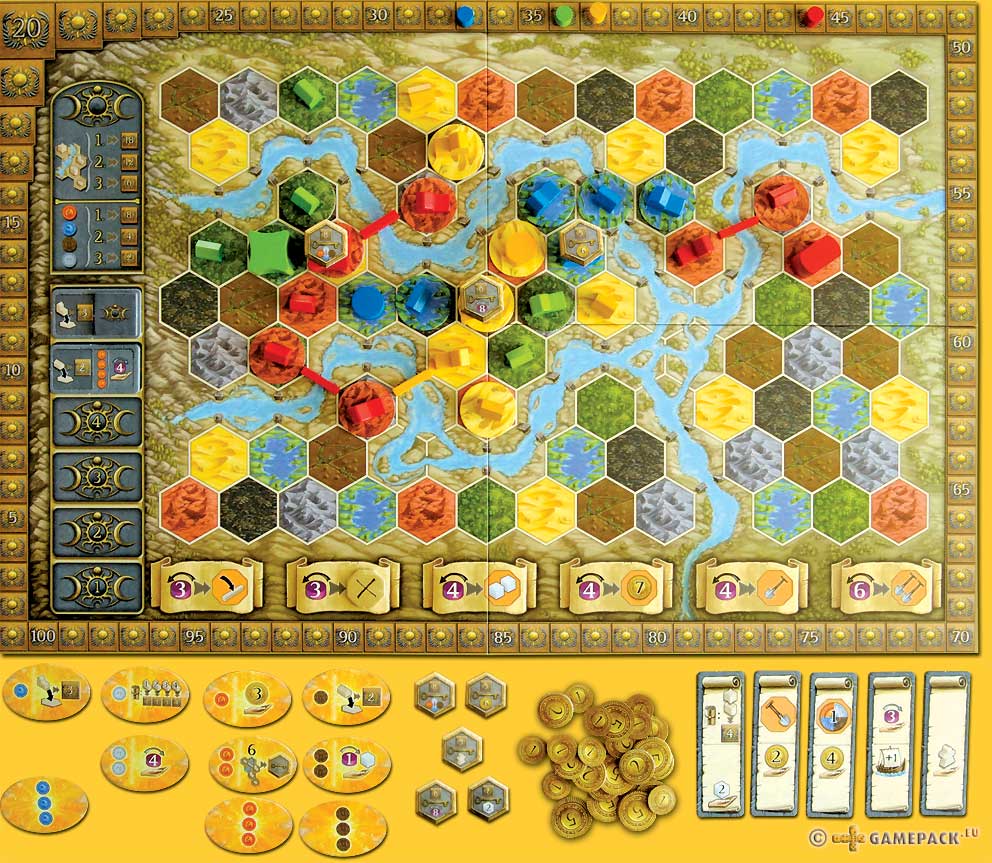 |
| x |
| x |
| x |
 |
|
|
|
|
|
|
|
|
|
|
|
|
|
|
|
|
|
|
|
|
|
|
|
|
|
|
|
|
|
|
|
|
|
|
|
|
|
|
|
|
|
|
|
|
|
|
|
|
|
|
|
It may already be somewhat apparent from the description: in Terra Mystica it’s extremely important to keep track of what your opponents are doing! Apart from the nice gift of power when someone builds next to you, there is competition everywhere: for suitable land to build on, for desirable bonus cards and power actions, on the cult tracks and for the area bonus. Anyone who thinks the game has no interaction merely because you can’t attack each other and tear down your opponents’ structures, is sadly mistaken.
|
|
|
| x |
|
|
|
|
|
|
|
|
|
|
|
|
|
|
|
|
|
|
|
|
|
|
|
|
|
|
|
|
|
|
|
|
|
|
|
|
|
|
|
|
|
|
|
|
|
|
|
|
|
|
|
|
|
|
|
|
|
|
|
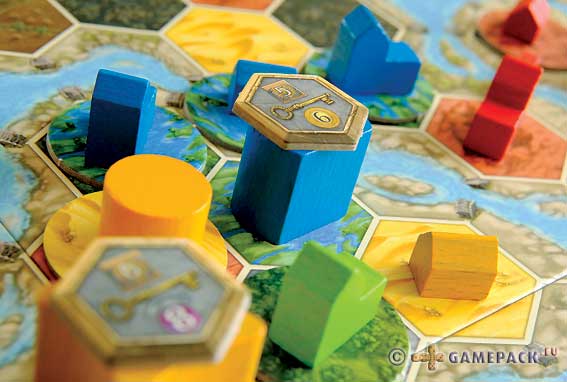 |
|
|
|
|
|
|
|
|
|
|
|
|
| x |
|
|
|
|
|
|
|
|
|
|
|
|
|
|
|
|
|
|
|
|
|
|
|
|
|
|
|
|
|
|
|
|
|
|
|
|
|
|
|
|
|
|
|
|
|
|
|
|
|
|
|
|
|
|
|
|
|
|
|
|
Relatively few games have an asymmetry between players: so generally it doesn’t matter at all which color or which character you are. Terra Mystica has substantial asymmetry: not only are the special powers wildly divergent, the building costs and the income they bring can also vary quite a bit! Inevitably this will raise the question in some quarters whether or not the game is ‘balanced’. In the games we played so far there was no apparent imbalance. Maybe someone armed with a spreadsheet and all the faction boards will claim to be able to prove otherwise, but who would want to play with someone like that anyway? Just pick a faction and give it your best!
|
|
|
| x |
|
|
|
|
|
|
|
|
|
|
|
|
|
|
|
|
|
|
|
|
|
|
|
|
|
|
|
|
|
|
|
|
|
|
|
|
|
|
|
|
|
|
|
|
|
|
|
|
|
|
|
|
|
|
|
|
|
|
|
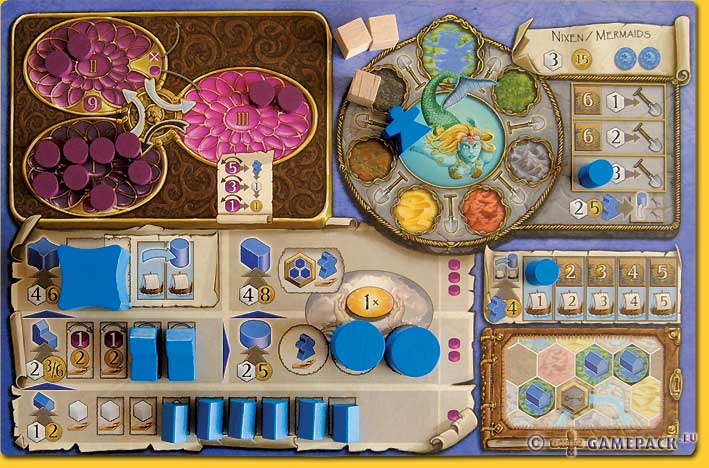 |
|
| x |
|
|
|
|
|
|
|
|
|
|
|
|
|
|
|
|
|
|
|
|
|
|
|
|
|
|
|
|
|
|
|
|
|
|
|
|
|
|
|
|
|
|
|
|
|
|
|
|
|
|
|
|
|
|
|
|
|
|
|
|
In the end interaction and game balance are not the most important things: it’s about the enjoyment in playing the game, and Terra Mystica has that ‘in spades’! The game is full of possibilities and temptations: expand or upgrade, take advantage of the round bonus or of my faction’s special powers? Everything is scarce, and especially for beginners it’s possible to become ‘stuck’ early in a round and be forced to pass quickly. But even then usually the predominant feeling is: 'Next time I’ll do better! And like this…'
|
|
|
| x |
|
|
|
|
|
|
|
|
|
|
|
|
|
|
|
|
|
|
|
|
|
|
|
|
|
|
|
|
|
|
|
|
|
|
|
|
|
|
|
|
|
|
|
|
|
|
|
|
|
|
|
|
|
|
|
|
|
|
|
 |
|
|
|
|
|
|
|
|
|
|
| x |
|
|
|
|
|
|
|
|
|
|
|
|
|
|
|
|
|
|
|
|
|
|
|
|
|
|
|
|
|
|
|
|
|
|
|
|
|
|
|
|
|
|
|
|
|
|
|
|
|
|
|
|
|
|
|
|
|
|
|
|
More praise? With 14 different factions replayability is huge, and the game even makes some sense thematically: dwarves digging tunnels, fakirs on flying carpets and mermaids who don’t let a bit of water bother them. All this makes Terra Mystica the highlight of an already excellent crop of new games!
© 2013 Ugur Donmez
Terra Mystica, Jens Drögemüller & Helge Ostertag, Feuerland Spiele, 2012 - 2 to 5 players, 12 years and up, 100 minutes
|
|
|
  |
|
|
|
|
|
|
|
|
|
|
|
|
|
|
|
|
|
|
|
|
|
|
|
|
|
|
|
|
|
|
|
|
|
|
|
|
|
|
|
|
|
|
|
|
|
|
|
|
|
|
  |
|
|
|
|
|
|
|
|
|
|
|
|
|
|
|
|
|
|
|
|
|
|
|
|
|
|
|
|
|
|
|
|
|
|
|
|
|
|
|
|
|
|
|
|
|
|
|
|
|
|
|
|
|
|
|
|
  |
|
|
|
|
|
|
|
|
|
|
|
|
|
|
|
|
|
|
|
|
|
|
|
|
|
|
|
|
|
|
|
|
|
|
|
|
|
|
|
|
|
|
|
|
|
|
|
|
|
|
|
|
|
|
|
|
|
  |
|
|
|
|
|
|
|
|
|
|
|
|
|
|
|
|
|
|
|
|
|
|
|
|
|
|
|
|
|
|
|
|
|
|
|
|
|
|
|
|
|
|
|
|
|
|
|
|
|
|
|
|
|
|
|
|
|
  |
|
|
|
|
|
|
|
|
|
|
|
|
|
|
|
|
|
|
|
|
|
|
|
|
|
|
|
|
|
|
|
|
|
|
|
|
|
|
|
|
|
|
|
|
|
|
|
|
|
|
  |
|
|
|
|
|
|
|
|
|
|
|
|
|
|
|
|
|
|
|
|
|
|
|
|
|
|
|
|
|
|
|
|
|
|
|
|
|
|
|
|
|
|
|
|
|
|
|
|
|
|
  |
|
|
|
|
|
|
|
|
|
|
|
|
|
|
|
|
|
|
|
|
|
|
|
|
|
|
|
|
|
|
|
|
|
|
|
|
|
|
|
|
|
|
|
|
|
|
|
|
|
|
  |
Despite the hype, it just is an overproduced development game. |
|
|
|
|
|
|
|
| x |
|
|
|
|
|
|
|
|
|
| x |
|
|
|
|
|
|
|
|
|
|
|
|
|
|
|
|
|
|
|
|
|
|
|
|
|
|
|
|
|
|
|
|
|
|
|
|
|
|
|
|
|
|
|
|
|
|
|
|
|
|
|
|
|
|
|
|
|
|
|
 |
|
|
|
|
|
|
|
|
|
|
|
|
|
|
|
|
|
|
|
|
|
|
|
|
|
|
|
|
|
|
|
|
|
|
|
|
|
|
|
|
|
|
|
|
|
|
|
|
|
|
 |
|
|
|
|
|
|
|
|
|
|
|
|
|
|
|
|
|
|
|
|
|
|
|
|
|
|
|
|
|
|
|
|
|
|
|
|
|
|
|
|
|
|
|
|
|
|
|
|
|
|
| x |
|
|
|
|
|
|
|
|
|
|
|
|
|
|
|
|
|
|
|
|
|
|
|
|
|
|
|
|
|
|
|
|
|
|
|
|
|
|
|
|
|
|
|
|
|
|
|
|
|
|
|
|
|
|
|
|
|
|
|
 |
|
|
|
|
|
|
|
|
|
|
|
|
|
|
|
|
|
|
|
|
|
|
|
|
|
|
|
|
|
|
|
|
|
|
|
|
|
|
|
|
 |
|
|
|
|
|
|
|
|
|
|
|
|
|
|
|
|
|
|
|
|
|
|
|
|
|
|
|
|
|
|
|
|
|
|
|
|
|
|
|
|
|
|